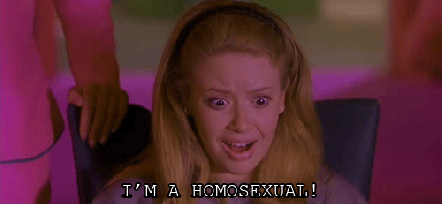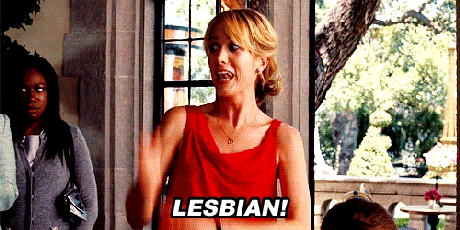Last year I wrote a Guide to Ladies Loving Ladies on Television. This year I thought I'd follow it up with a similar guide for films. Everyone wants to have pop culture figures that they feel they can identity with and that's why many members of the LGBT community will seek out movies and TV shows that showcase LGBT characters. Who among us hasn't watched a film just because we heard there were lesbians in it? I decided to put together a guide of LGBT ladies in film for anyone who is looking for some characters they can relate to. This blog will take you through the evolution of LGBT women characters in film and point out a some of the most influential and famous ones. Also, SPOILERS. You have been warned.
Cross-Dressing to Challenge Gender Roles
In the early days of film lesbianism was a taboo subject, if it even came up at all. The first forays into queerness for ladies on film came with gender-bending cross-dressing. Katharine Hepburn plays two of these roles. First in Christopher Strong (1933) and again in Sylvia Scarlett (1936) she plays Sylvia who disguises herself as a boy to avoid suspicion while running from the cops with her father. Queen Christina (1933) showed Sweden's famous Queen as she preferred to dress and Morocco (1930) featured the infamous scene of Marlene Dietrich in a top-hat and a suit.
Eventually lesbianism was allowed to shown (or at least hinted at) on screen. While the films could show it, they could definitely not be condoning it, which is why many of them were portrayed as antagonists and even straight up villains. In Rebecca (1940) it was terrifying Ms. Danvers haunting poor Joan Fontaine. There's also Caged (1950) and The Balcony (1963) that show LGBT women in questionable light.
Perhaps an extension of the villainous lesbian trope is the lesbian vampire one. Vampirism is something sexy yet forbidden; alluring yet dangerous. It makes sense that this was how lesbianism was thought of as well. Dracula's Daughter (1936) was the first film to touch on this but did so in a suitably subtle way. It wasn't until decades later that exploitation came into play for lesbian vampires. Blood and Roses (1960) retells the famous Joseph Sheridan Le Fanu story of Carmilla. Other tales of female vampires preying on unsuspecting victims were extremely popular in the 1960's and 1970's including Vampyros Lesbos (1971), Countess Dracula (1971), and another Carmilla story, The Vampire Lovers (1970). The Hunger (1983)'s villains were much more three-dimensional than it's predecessors. In today'a age, lesbian vampire usually appear in low-budget horrors such as We Are the Night (2010) or as a satire in one of my personal favorite, Lesbian Vampire Killers (2009), which seems to mock society's sexualization with LGBT women.
Eventually the censors started to allow more overt lesbian tones in films. However, being gay was still very much frowned upon. This meant that gay and lesbian characters in the mid-20th century could never have happy endings. They also somehow had to pay the ultimate price for their sexuality, whether that be unhappiness or even death.
The Children's Hour (1961), The Fox (1967) The Killing of Sister George (1968), Personal Best (1982) and Lianna (1983) all show the unhappiness that being queer will bring you and despite having representation, declines to show many positives that go along with being openly LGBT.
By the 1980's we finally started seeing LGBT characters who weren't brutally murdered or otherwise an example of moral misbehavior. The shining beacon of light was Dessert Hearts (1985) about two women who fall in love at a Nevada Ranch. After that came a flurry of three-dimensional lesbian characters in films that explored the realistic and diverse lifestyles of LGBT ladies. Some of these include Go Fish (1994), Watermelon Women (1995), The Incredibly True Adventure of Two Girls in Love (1995), When Night Is Falling (1995) Better Than Chocolate (1999), and If These Walls Could Talk 2 (2000). This all culminated in the social commentary satire turned cult classic But I'm A Cheerleader (2001).

After this period films featuring LGBT characters and plot-lines because much more frequent and varied.
Dark Dramas: Twisted and Sad
Some of these lesbian-themed dramas come with dark themes or deep plots. Bound (1996) is about two lovers and their crimes. Heavenly Creatures (1994) is about two girls who lash out against their parents. Fire (1996) is the poignant tale of two women in India who must hide their love. The Fish Child (2009) and Mulholland Dr. (2001) are two other films with dark themes that feature LGBT relationships.
Dramas; Romance and Otherwise
Many of these films feature typical romantic plot-lines of two ladies falling in love. I Can't Think Straight (2008), Kissing Jessica Stein (2001), Kiss Me (2011), Saving Face (2004) Elena Undone (2010), High Art (1998), Room in Rome (2010), and Imagine Me & You (2005) all touch on the nuances of love and romance with varying levels of drama, comedy, and culture clash.
Comedy; Kick-Ass and Cute
LGBT ladies also got their due in the comedy genre, usually combined with drama and romance. And Then Came Lola (2009), Itty Bitty Titty Committee (2007), Chasing Amy (1997), D.E.B.S. (2004), and Bitch Slap (2009) all fall somewhere into the realm of comedy and romance and the latter two with some nice action scenes as well.
Lesbians in the Horror Genre
While lesbian vampires will also be popular, LGBT ladies have infiltrated all sub-genres of horror including supernatural, zombie, werewolf, and more. You can go for a more serious drama with horror elements like B lack Swan (2010) or Jack & Diane (2012) or you can choose a more strictly horror film like the horror comedy All Cheerleaders Die (2013) or creepily awesome Contracted (2013).
Some of the most important LGBT films include those of teenage exploration and revelations. These are the films that young LGBT ladies can watch and relate to. Many of these are foreign films, for example Show Me Love (1998) is from Sweden and Water Lillies (2007) is from France. My Summer of Love (2004) stars a young Emily Blunt, Lost and Delirious (2001) is one we love to hate-watch on Netflix and The Truth About Jane (2000) is a TV movie starring Stockard Channing.
Lest we forget that there have been LGBT ladies for thousands of years, there are plenty of period films with lesbian themes as well. The World Unseen (2007) takes place during South Africa's apartheid era. Farewell, My Queen (2012) is about Marie Antoinette. Tipping the Velvet (2002), Sister My Sister (1994), and Fingersmith (2005) all take place in Europe. Aimee & Jaguar (1999) is a fantastic WWII drama about love between a Jewish woman and a Nazi's wife.
Student-Teacher Relations
Sometimes the predatory lesbian trope sticks around and nowadays it's usually in the form of a teacher acting inappropriately with a student. Many of these films are lower-budget and lesser-known such as Loving Annabelle (2006) and Bloomington (2010). Cracks (2009) is a film with higher production value and features a fantastic performance by Eva Green.
As the world evolves socially and becomes more accepting of LGBT culture we have seen numerous critically-acclaimed and award-winning films revolving around LGBT ladies. Some films use queer sexuality as their focal point, such as Boys Don't Cry (1999), The Kids Are Alright, and Blue is the Warmest Color (2013). Others like Monster (2003) and Circumstance (2011) feature LGBT characters with other, non-sexuality related conflicts in their lives.
2015 will give us a few different films about LGBT ladies. The first hasn't garnered spectacular reviews but you know we will all watch it anyway and that is Jenny's Wedding (2015). The other two are Carol (2015) and Freeheld (2015), both of which have gained award-season buzz lately. Starring Cate Blanchett and Rooney Mara, Carol is about two women who fall in love in 1950s New York. Freeheld is the true story of Laurel Hester and Stacie Andree who fought for equal rights issues. Freeheld will star Ellen Page and Julianne Moore.

There are plenty more films out there that feature LGBT women and themes, it would be difficult to name them all. I hope this blog was informative and even entertaining and please feel free to suggest more films in the comments!

